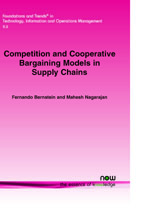Competition and Cooperative Bargaining Models in Supply Chains
By Fernando Bernstein, The Fuqua School of Business, Duke University, USA, fernando@duke.edu | Mahesh Nagarajan, Sauder School of Business, University of British Columbia, Canada, mahesh.nagarajan@sauder.ubc.ca
Abstract
In the last two decades or so, a significant emphasis of the research literature in operations management has been on the strategic interaction of firms in a supply chain. Individual firms in supply chains make decisions on multiple levers such as capacity, inventory and price, to name a few, that have consequences for the entire supply chain. In modeling strategic interactions, the operations literature has followed the large literature in industrial organization and economics. Competition between firms in a supply chain has largely been modeled using noncooperative game theory and the associated concepts of equilibrium that predict the outcomes. There are a few key differences between the industrial organization literature and the research in operations management. First of all, the operations literature looks more at operational variables, such as capacity and inventory, as a response to various sources of process uncertainty that any firm faces. The preferences of individual customers, their valuations and the construction of the specific form of the uncertainty is less of a concern (although more recent literature emphasize this). Second, the findings in the operations literature usually have the objective of improving individual firms' (and supply chains') profits and operational efficiencies rather than one of dictating economic policy. Third, although non-cooperative models are the norm, there is also an underlying emphasis in the operations literature on cooperation between firms in a supply chain to improve the overall profit of the supply chain. This is probably because, unlike the levers traditionally studied in economics, many operational variables in a supply chain are often jointly decided between firms. The goal of this review taps on this last sentiment. We provide an overview of some of the basic multi-firm models studied in supply chain management. We look at how the literature uses non-cooperative game theory to analyze these models. We then look at how some of these models can be analyzed using a cooperative bargaining framework. We compare the modeling tools and the insights one obtains by taking this twofold approach. This process also allows us to discuss a few topics of interest such as the relative channel power of a firm, the relative merits of using a non-cooperative game versus cooperative bargaining to model a supply chain setting, etc. Finally, we conclude this review by exploring some issues that remain unresolved and are topics for future research.
Competition and Cooperative Bargaining Models in Supply Chains
Competition and Cooperative Bargaining Models in Supply Chains reveals that cooperation between firms in a supply chain can improve the overall profit of the supply chain. It provides an overview of the basic multi-firm models studied in supply chain management. The authors look at how the literature uses non-cooperative game theory to analyze these models and considers how some of these models can be analyzed using a cooperative bargaining framework. This monograph compares the modeling tools and the insights obtained by taking this two-fold approach. The authors discuss a few topics of key interest including the relative channel power of a firm and the relative merits of using a non-cooperative game versus cooperative bargaining to model a supply chain setting. This monograph concludes by exploring some issues that remain unresolved and are topics for future research.
